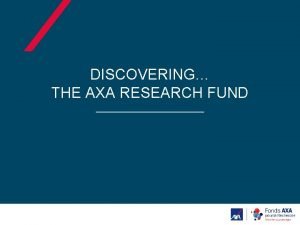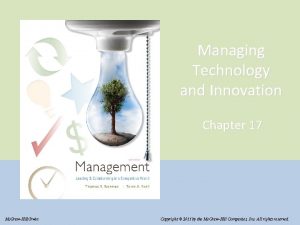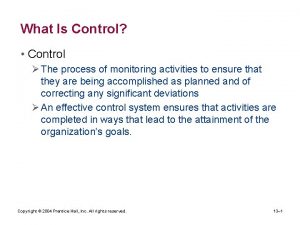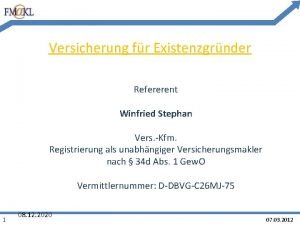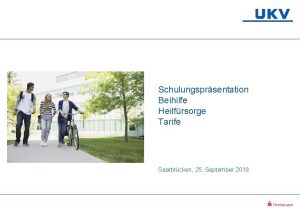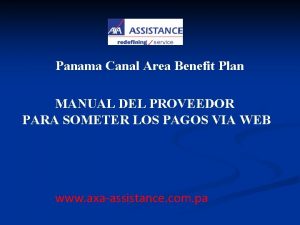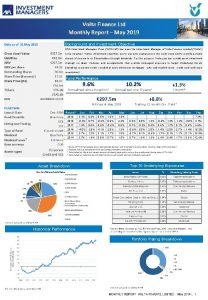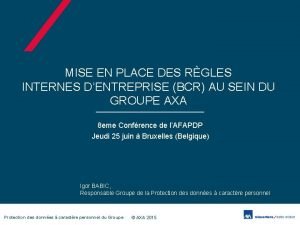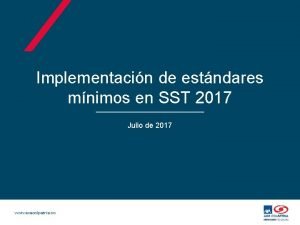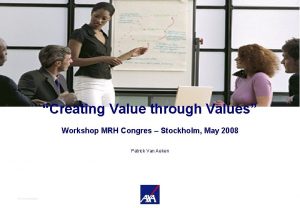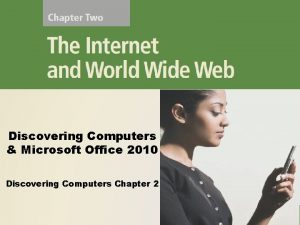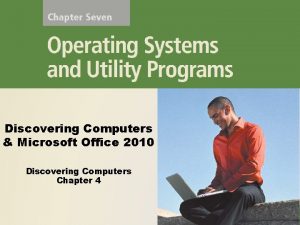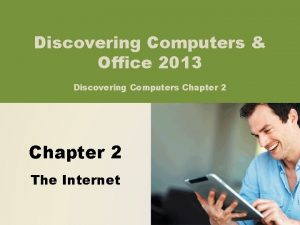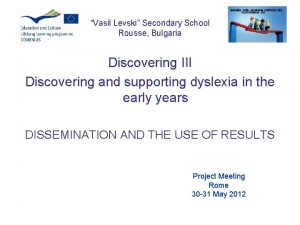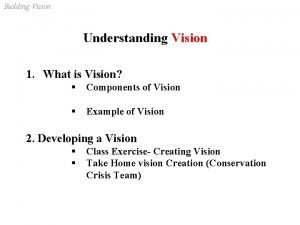DISCOVERING THE AXA RESEARCH FUND An anticipated vision

















- Slides: 17

DISCOVERING… THE AXA RESEARCH FUND

An anticipated vision of risk management & commitment towards human progress The AXA Research Fund is the science philanthropy initiative of the AXA Group that seeks to advance knowledge on global risks for the benefit of Society. “ As a leading insurer, our key expertise lies in understanding and managing risk, our key responsibility in protecting people. This means that we have an essential and active role to play in making sure the everevolving risk landscape – the greatest coming from where it is least expected - is understood by society as a whole. “ 2

An anticipated vision of risk management & commitment towards human progress Support academic research Contribute to the & public debate on risks « To know and share the knowledge » Created in 2007 with an initial enveloppe of 100 M€ + Renewed in 2013 for an additional 100 M€ = 200 M€ until 2018 12 people A team of hosted @ GIE AXA 3 clusters of risks: Focus on Advisory Board An gathering AXA Heads of Group Professionnal Families to identify and prioritize the most relevant research areas to be funded Scientific Board A gathering World Renowned Researchers and AXA Senior Executives to select and support Top-Tier 3 Researchers - Life - Environment - Socio-economic Main missions: • Academic partnerships • Selection of grantees • Community and communication management

Which fields do we support? Identifying Mitigation / Prevention Solutions Environmental risks Climate Change Natural Hazards Human driven Environmental Changes Assessing the Social and/or Economic Impact 4 Foster the understanding of major risks in 3 main fields Life risks Aging and Long-term Care Understanding Causes & Underlying phenomena Socio-economic risks Geopolitical Risks Macroeconomic Risks Biomedical Risks Addictions and Risky Behaviors Measuring and Modeling the Risk Behaviors Towards Risks Large Corporate Risks Identifying the Mecanisms at stake

A unique commitment of support to research, of a large magnitude 1300+ institutions registered in 67 countries n Selection criteria aligned with the most rigorous academic standards n 143 M€ committed to date: n n o 484 projects o Supported in 230 institutions o 50 nationalities of researchers o Granted in 33 countries Strong communications initiatives o 1 academic publication a day (average) o 200+ press articles o 100+ Youtube videos o 3000+ Twitter followers… The AXA Research Fund funding vehicles cover the full cycle of a Researcher’s carrier path Junior Post Doctoral Fellowships 2 years - 130. 000€ 25 per year 5 Mid-carrier Awards 3 -4 years 250. 000€ 3 to 5/year Joint Research Initiatives 2 -3 years - up to 200. 000€ Up to 4 per year Senior AXA Chairs 5 to 30 years up to 3 M€ 3 to 8 per year

Our selection processes are aligned with the most stringent academic standards Context & environment appropriateness Transformative aspect & strategic fit Institution Research Laboratory (in the Institution) Research Strategy (of the Research Laboratory) Candidate Research Project (of the Candidate) Academic fit Gender mix Distance to Risk Business strategic alignment Academic excellence International exposure Geographical footprint 6 Popularization skills Thematic diversity Mobility Seniority Reverse Brain Drain Transformative impact

Projects granted… A few examples

Chair for Cardiovascular Cellular Engineering Prof. Abdul Barakat - Amount granted = 2. 000 € Insight Traditionally, medicine and engineering have lived in two different and separate worlds. Now though, researchers from each world are beginning to see how much they each stand to benefit from the unique tools and approach of the other. Nowhere is this more true than in the ongoing battle against cardiovascular disease, the world’s leading cause of mortality. § Heart disease and strokes are caused by atherosclerosis, or the thickening of the arterial walls which leads to arterial blockage by lipid-rich plaques. § This Chair is one of the first instances in which atherosclerosis will be studied through a trans-disciplinary approach that combines biology and engineering. § The Research Team is hosted by the Lad. Hyx, a lab which conducts theoretical, numerical and experimental researches in fundamental Fluid Dynamics. At its beginning, activities were focused on Instabilities and transition to turbulence in shear flows, but new topics have emerged : geophysical flows, fluid-structure interactions, mechanics and living systems… Future Research Agenda This AXA - École Polytechnique Chair aims to develop a new generation of engineers sufficiently versed in biology to formulate original approaches to these diseases, and contribute to the understanding of the role that arterial fluid mechanics play in the development of atherosclerosis. 8

Chair in Neuroergonomics for flight safety Prof. Frédéric Dehais - Amount granted = 1. 000 € Insight Safety analysis reveals that the complexity of modern transportation aircraft can overwhelm even the most experienced human operators when something goes wrong. Generally, pilots are confused and face perseveration, a behavior that leads them to neglect critical information (e. g. auditory alarms) and to persist in irrational decision-making. § An innovative way to address these challenging safety issues is to merge knowledge and methods from Neurosciences, Human Factors and Computer Science. § The objective of the research program is to consider this approach known as Neuroergonomics, to uncover the underlying neural mechanisms of the perseveration phenomenon, to identify the risk factors that provoke this behavior and to propose solutions to mitigate its effects. § Indeed the Chair involves a unique methodology “from basic protocols to ecological experiments” and intends to combine cutting edge brain imaging, signal processing, and artificial intelligence techniques, as well as physiological and eye tracking techniques. Future Research Agenda Results from this project will be strongly beneficial for aviation safety as this domain is at the core of ISAE. It is also intended that these results regarding perseverative behavior and irrational decision-making will be transferrable to other critical domains (e. g. automotive) and the rehabilitation of patients with cerebral lesions. 9

Chair in Financial Market Risk Prof. Joel Peress - Amount granted = 2. 000 € Insight On April 23 rd, 2013, just after 6 pm, all hell broke loose in Wall Street: markets dived in less than 2 minutes after computer hackers high-jacked the Associated Press Twitter account, falsely claiming President Obama had been injured in 2 explosions at the White House. Stock markets took 5 minutes to get back to normal, which illustrates the speed and tremendous impact of social and mass media on asset prices. § “Everything is short lived in financial behavior and knowledge” says Joel Peress, AXA Professor at INSEAD Business School. His work on information in financial markets challenges conventional models of propagation of information through prices. § In a study covering two decades and several countries, he found falls in trading volume (-12%) and price volatility (7%) on days newspapers went on strike. His analysis of return predictability also indicates that it takes one day for news to propagate to markets through newspapers. § Information-diet impact was strongest for small-cap stocks, commonly traded by retail investors who rely more than big institutional investors on the media for information. Future Research Agenda These findings demonstrate that the media contribute to the efficiency of the stock market by improving the dissemination of information among investors and its incorporation into stock prices. Prof. Peress will now explore the influence of social and digital media. 10

Post Doctoral Fellowship – Miss Tiziana Beltrame Mapping Cultural Heritage Risks: From Beauty to Fragility Insight This project seeks to analyze the preventive preservation practices of three European ethnographic museums: the Royal Museum for Central Africa (RMCA) in Tervuren - currently under renovation-, the Luigi Pigorini National Museum of Prehistory and Ethnography in Rome and the musée du quai Branly in Paris). § The project aims at analyzing the preventive conservation practices applied to the collections of European museums of ethnography. Heritage collections are preserved through the implementation of a set of continually changing measures that aim to minimize the risk of object degradation. These practices mobilize the know-how of laboratory science and technology, and could be said to create a new “art world”. § The constant redefinition of conservation practices has an effect on the history of the collection. The technical manipulations involved in ethnographic object conservation operations change the relationship that scientists, curators and technicians have with the object. These spheres of digital and physical object management are often based in the background of museography, to the point of becoming invisible. In fact, the objects’ properties are not the set attributes of matter, they are processual and relational. Future Research Agenda This project will investigate the role of the object's constitutive material in the patrimonialization and artification of ethnographic collections. In order to stabilize the object, links are established between patrimonialization practices and those of laboratory sciences like chemistry, physics or biology and technology. Computerization allows the object's variations to be recorded, enabling patrimonial risk to be tracked and mapped. Miss Beltrame will explore how in these material ecologies the artifact/art objects are defined and controlled. This project aims also to analyze the changes in the field of material culture and museum studies. 11

Chair for the Improvement of Healthcare Quality Dr. Pedro Saturno - Amount granted = 1. 000 € Insight The program will focus on structuring a system-wide initiative to improve the quality of the services provided. This will imply basic implementation research around the different strategies, which may act in synergy, while considering six key dimensions of quality (effectiveness, efficiency, patient-centered care, accessibility, equity, safety). § In Mexico the right to health care is legally acknowledged and there are multiple provisions to make it effective (program to insure people without Social Security, nationwide free of charge public programs targeted to pregnant women…). However, data show that over 20% of the population is still uncovered, maternal mortality is three times higher than the ratio in other similar Latin-American countries, infant mortality is deceptively high, and fully vaccinated children at 1 year of age is 60. 7%. § The hypothesis is that a multifaceted intervention using the principles of quality improvement and community involvement may be successful to achieve the officially sought (but not well implemented) equity in the provision of health services, and the needed changes in health seeking behavior of the communities. This approach combines several initiatives credited with successful histories separately, but have never been implemented jointly, and advances democratic development and human rights. Future Research Agenda The research program will primarily focus on (i) Measurement tools and indicators for the different quality dimensions; (ii) Factors, human and organizational, influencing quality and quality improvement; (iii) Research on effective strategies for quality improvement. 12

Chair in Household Finance and Insurance Prof. Luigi Guiso - Amount granted = 500. 000 € Insight What makes transactions possible? According to Prof. Guiso, the answer is trust. Any financial exchange, whether it be an investment decision, the granting of a loan, the purchase of an insurance policy or the acceptance of a check to settle a transaction, is an exchange of money today for the promise of returning (more) money in the future. § “Today, household finance is a thriving, vibrant, self- standing field” stated Professor Guiso. To give a sense of the relevance of household finance, the value of assets and liabilities held by households is much larger in most countries than the financial assets held by corporations. To the extent that market size is a measure of importance, household financial decisions deserve due attention. § Trust is even more important for households, whose choices are not always easy to understand, due to their extreme diversity. That’s why expanding existing models of households’ financial decisions to allow not only for diversity in preferences for risk but also in peoples beliefs towards other people behavior will better capture households interactions with financial markets. Future Research Agenda Professor Guiso will study new models of behavior in the face of risk and uncertainty that might take into account a richer characterization of preferences and additional dimensions of risk, including social risk. The findings of this research program will be relevant for policy debates, such as those related to the role of financial literacy and the regulation of intermediaries offering financial products to households. 13

Joint Research Initiative - Amount granted = 200. 000 € Insurance for building trust and enabling Big Data Insight Despite efforts of data administrative agencies (CNIL in France), and development of data protection legislation, the huge extension of personal data circulation is not under control. This concern is not shared by the public and every individual contributes to the flaws of the system through their own negligence so that we might face a “Fukushima of personal data”. Principle Investigator Sciences Po Média. Lab Dominique Boullier Project Manager AXA Data Innovation Lab Bruno Aïdan § The project will redesign the conceptual framework of personal data by moving towards a deeper understanding of what the relationship to one’s data is constituted. Personal data must be considered as a/ flows and not stocks, b/ transactional and not personal, c/ distributed and not located, d/ embedded in specific social worlds and not general and e/ regulated and not owned. § The objective of this project is to study what could be the role of insurance products in enhancing trust while Big Data Technologies are expanding their reach. The project will address the complete set of conditions required for an insurance policy to enter the business of personal data by providing a guarantee on the quality of information systems using personal traces data. Future Research Agenda § The project aims at providing a full understanding of 1) risks related to data, 2) qualities and loopholes of insurance offers, social networks policies and CGU about personal data management, 3) perception of risk of the layman along with his/her experience related to personal data hazards, 4) controversy on privacy and personal data, 5) actors and stakeholders involved in the resolution of the dispute about privacy in the digital world. 14

Joint Research Initiative Machine Learning for Large-Scale Insurance Data Insight Machine learning is a recent scientific domain, positioned between applied mathematics, statistics and computer science. Its goals are the optimization, control, and modeling of complex systems from examples. Machine learning is characterized by the high quality and quantity of exchanges between theory, algorithms and applications. Principle Investigator PSL* Alexandre d’Aspremont Project Manager AXA Global Direct Emmanuel Pierron § Research objectives are primarily focused on supervised learning, unsupervised learning, parsimony and convex optimization. However, given recent changes in our academic and societal environments, we plan to put a stronger emphasis on three themes described below: (a) trade-offs between computation and statistics, (b) robustness of unsupervised learning, and (c) structured prediction. § In the last few years, the expression “big data” has become a keyword in many areas of science, engineering and industry. However, the most impactful recent change is not the size of the data but its ubiquity. The prevalence of data, which will be at the core of the collaboration with AXA, is a strong opportunity for machine learning to showcase its recent progress, and it comes with new research questions. Future Research Agenda The research team strives to achieve a triple objective, which is necessary for high impact: rigorous theory, efficient algorithms, and improved performance in applications. Therefore, the project aims at bridging the gap between theory and practice in machine learning. This naturally leads to scientific challenges such as fully automated data processing, incorporating structure & large-scale learning. 15

Questions?

Our institutional movie… Thank you And let’s keep in touch ! Raphaël Gusdorf – Research & Selection Office raphael. gusdorf@axa. com 17 MIHO JANVIER, Observatoire de Paris (France) - Solar flares, geomagnetic storms and their evolutions toward the Earth
 Raphael gusdorf
Raphael gusdorf Anticipated market receptiveness
Anticipated market receptiveness Operating budget example
Operating budget example Control that prevents anticipated problems is
Control that prevents anticipated problems is Petty cash management system
Petty cash management system Winfried stephan
Winfried stephan Litere care au axa de simetrie
Litere care au axa de simetrie Axa anwartschaftsversicherung soldaten
Axa anwartschaftsversicherung soldaten Willensmangel
Willensmangel Efectuați folosind proprietățile adunării
Efectuați folosind proprietățile adunării Axa assistance panama canal area benefit plan
Axa assistance panama canal area benefit plan Aflati coordonata fiecaruia dintre punctele
Aflati coordonata fiecaruia dintre punctele Axa investment manager paris
Axa investment manager paris Axa ransomware
Axa ransomware Axa bcr
Axa bcr Resoursable
Resoursable Axa mrh
Axa mrh Asteria vision fund
Asteria vision fund
